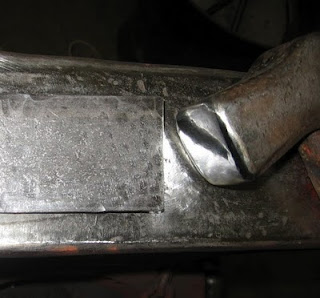


It occurred to me that over time there has been a change in my thinking about forming. This is something akin to the gestalt of seeing positive space or negative space.
It seems I used to think mostly about the forming process as how the work piece would have to move rather than how the radius of the tools would move the work. Today I spend more time thinking about how I want the surface too look - emphasizing the process marks or eliminating them.
The anvil is usually smoother and flatter than the hammer face. And too move metal quickly a short radius hammer such as a ball peen or rounding hammer is used. As the final form is approached a long radius forging hammer is useful if the chunky surface is to be worked to a smooth surface. Finishing the presentation face with a nearly flat planishing hammer can leave a very smooth surface.
I was taught that because the anvil face was the flattest and smoothest the surface toward the anvil was the “pretty face”. Today I often prefer more visible texture so the interesting side is up and the plain side is on the anvil face. Pretty side up.
The surface facets can be accentuated by hand sanding with 60 or finer grit sand paper or light filing and I do some of that but not much. Like with other surface accents of brass brushing or Guilder’s paste, I think a little goes a long way. I have spent a lot of time studying how I can use fire scaling followed by light tumbling to create the surface appearance I like best. I don't commonly use a wire brush to remove hot scale unless forge welding.
In the final analysis what shows in the work should be intentional so carefully picking the tools and making sure they are well dressed so they don’t leave unintentional marks is good craftsmanship.
Check out Care and Maintenance of a new or old anvil at:
http://www.blksmth.com/care_and_maintenance_of_anvils.htm

No comments:
Post a Comment